Biology Exam: Energy, Cells & Surviving - Year 8 Revision (2019)
VerifiedAdded on 2023/03/30
|32
|1919
|103
Homework Assignment
AI Summary
This document provides solutions to a Year 8 biology exam covering three main topics: Energy, Cells, and Surviving (Body Systems). The energy section addresses different forms of energy (kinetic, potential, etc.), energy transformation and transfer, and renewable vs. non-renewable energy sources, including energy efficiency and conservation methods. The cells section covers cell structures (nucleus, ribosomes, mitochondria, etc.), differences between plant, animal, fungi, and bacteria cells, cellular respiration, and the cell theory. The surviving section discusses blood components and their functions, the circulatory system, gaseous exchange in the lungs, the respiratory system, and the digestive system, including physical and chemical digestion and the functions of various organs. The exam also includes questions on specialized cells, unicellular and multicellular organisms, and microscope parts and magnification.
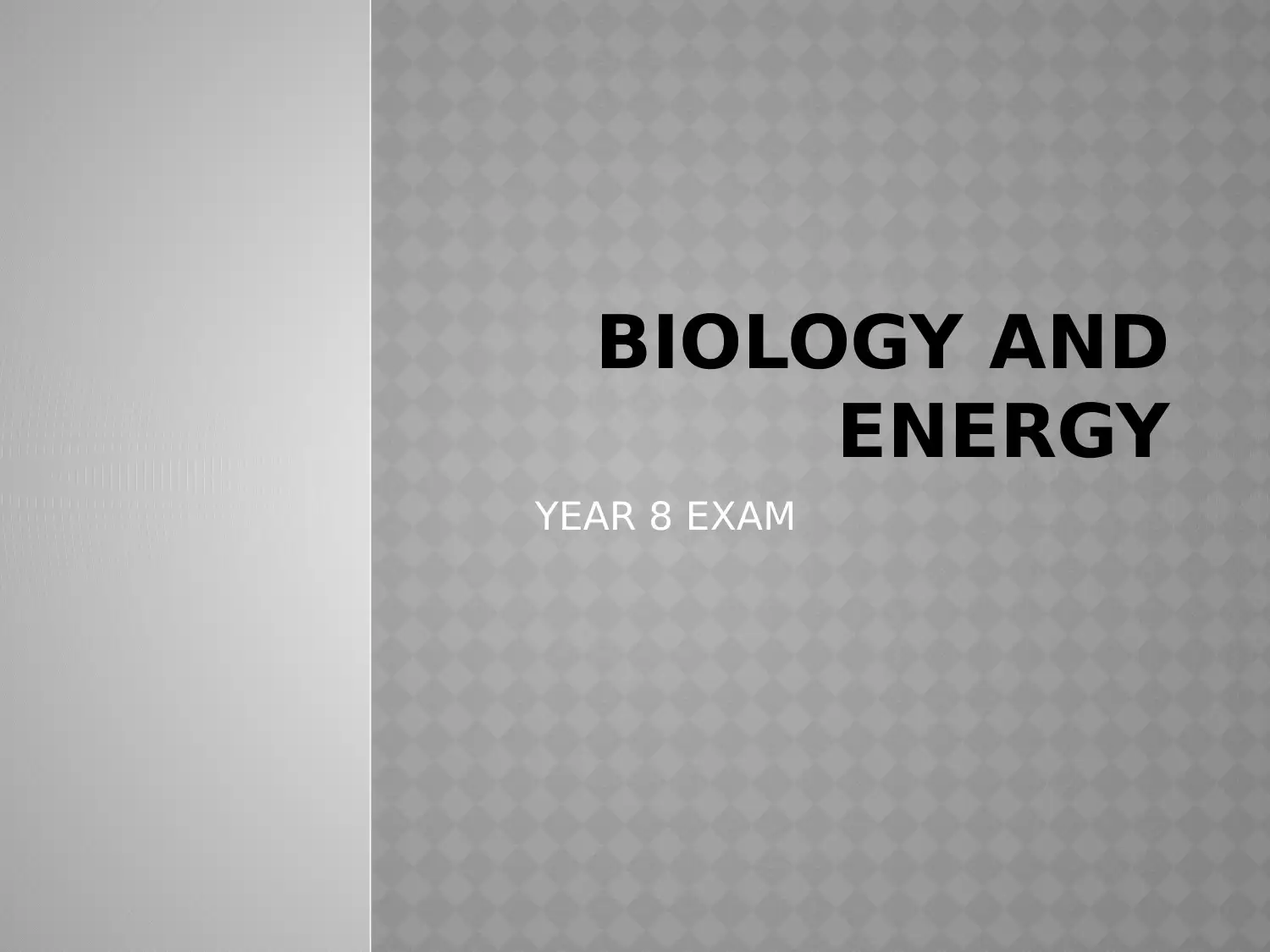
BIOLOGY AND
ENERGY
YEAR 8 EXAM
ENERGY
YEAR 8 EXAM
Paraphrase This Document
Need a fresh take? Get an instant paraphrase of this document with our AI Paraphraser
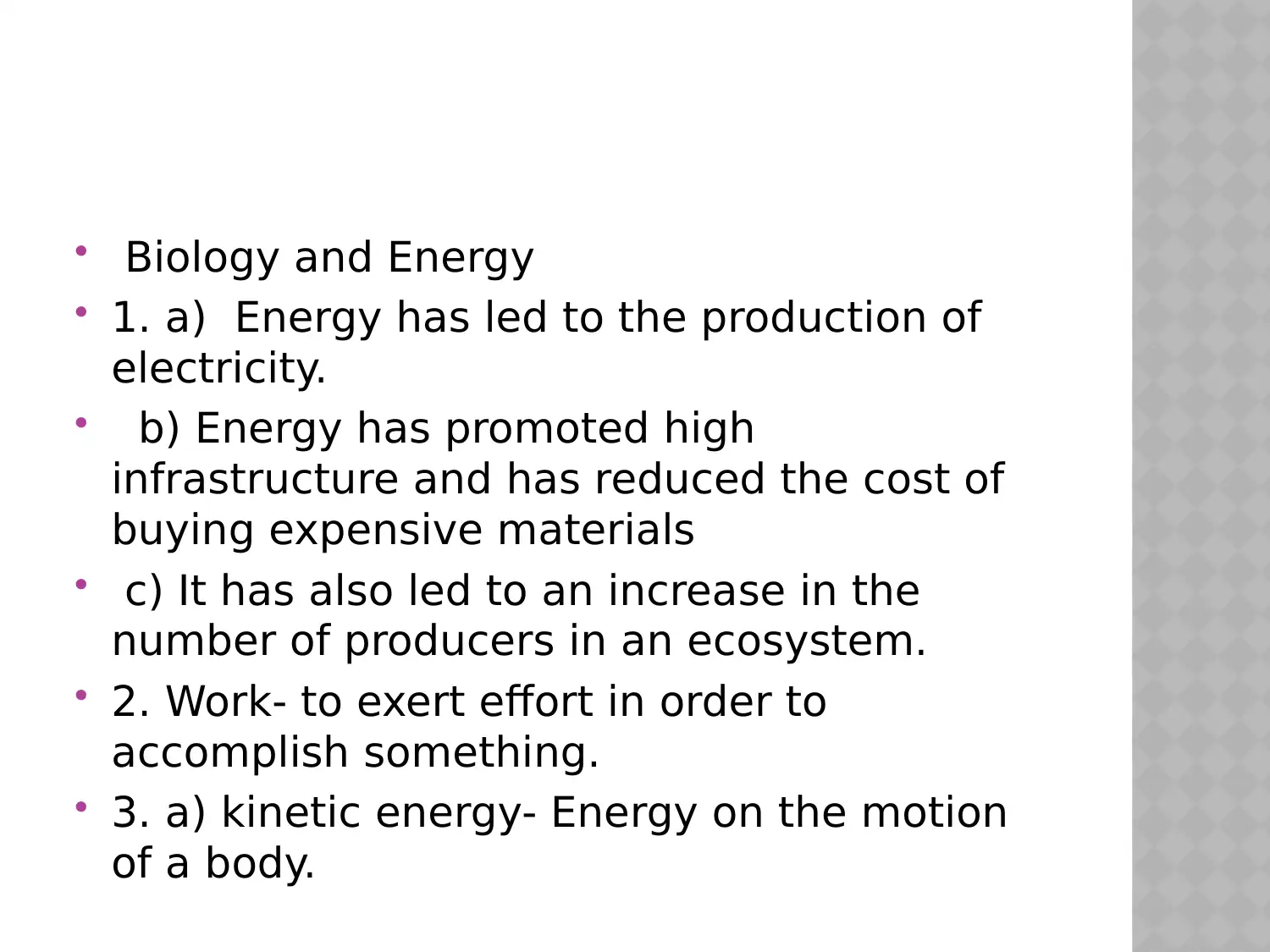
Biology and Energy
1. a) Energy has led to the production of
electricity.
b) Energy has promoted high
infrastructure and has reduced the cost of
buying expensive materials
c) It has also led to an increase in the
number of producers in an ecosystem.
2. Work- to exert effort in order to
accomplish something.
3. a) kinetic energy- Energy on the motion
of a body.
1. a) Energy has led to the production of
electricity.
b) Energy has promoted high
infrastructure and has reduced the cost of
buying expensive materials
c) It has also led to an increase in the
number of producers in an ecosystem.
2. Work- to exert effort in order to
accomplish something.
3. a) kinetic energy- Energy on the motion
of a body.
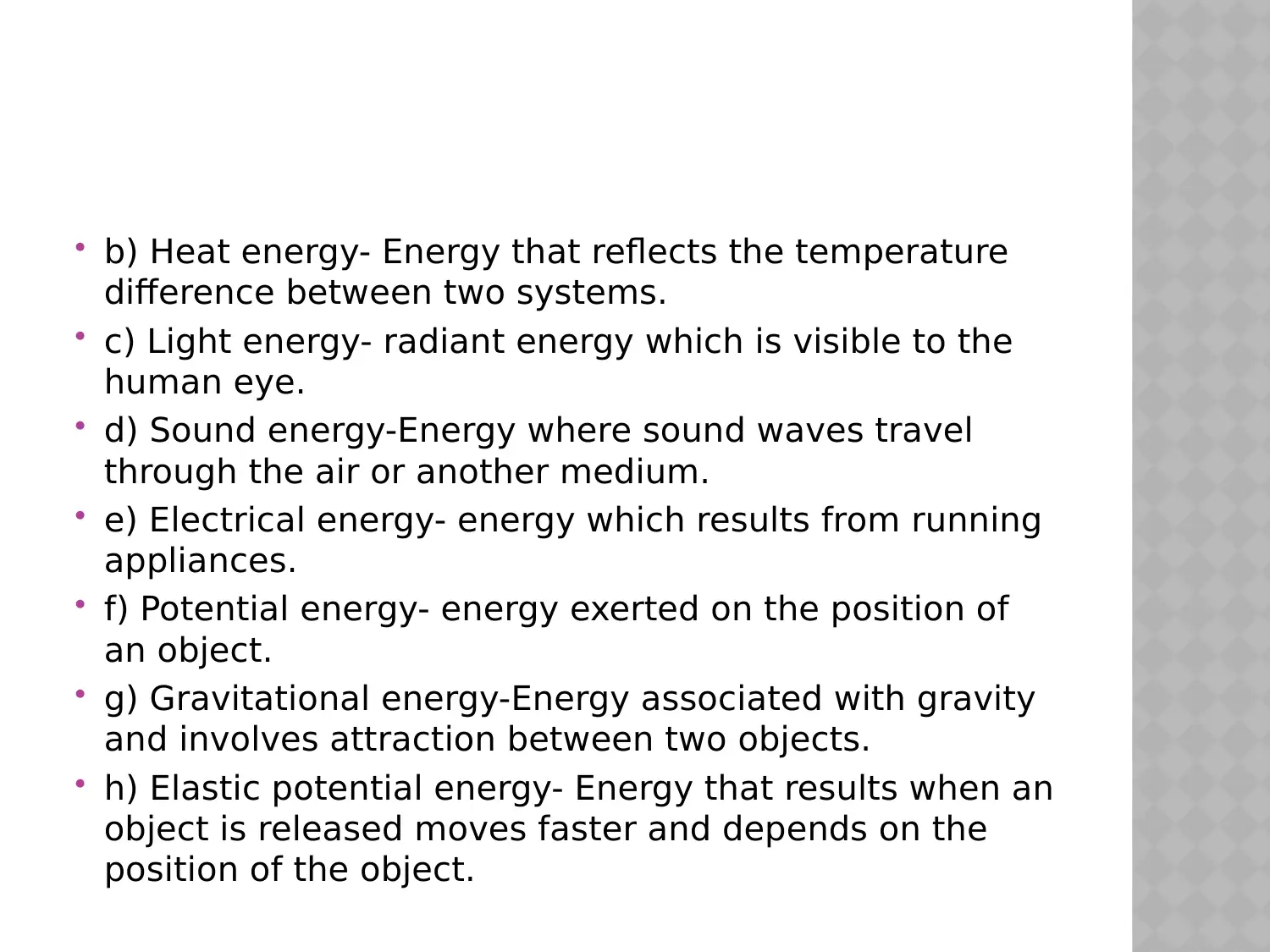
b) Heat energy- Energy that reflects the temperature
difference between two systems.
c) Light energy- radiant energy which is visible to the
human eye.
d) Sound energy-Energy where sound waves travel
through the air or another medium.
e) Electrical energy- energy which results from running
appliances.
f) Potential energy- energy exerted on the position of
an object.
g) Gravitational energy-Energy associated with gravity
and involves attraction between two objects.
h) Elastic potential energy- Energy that results when an
object is released moves faster and depends on the
position of the object.
difference between two systems.
c) Light energy- radiant energy which is visible to the
human eye.
d) Sound energy-Energy where sound waves travel
through the air or another medium.
e) Electrical energy- energy which results from running
appliances.
f) Potential energy- energy exerted on the position of
an object.
g) Gravitational energy-Energy associated with gravity
and involves attraction between two objects.
h) Elastic potential energy- Energy that results when an
object is released moves faster and depends on the
position of the object.
⊘ This is a preview!⊘
Do you want full access?
Subscribe today to unlock all pages.

Trusted by 1+ million students worldwide

4. A car has high kinetic energy while the blue
Honda has the highest gravitational energy. Due to
the force of gravity care moving up on a mountain
will have greater kinetic energy than a blue Honda
which moves on a flat surface thus exhibiting
potential energy.
5. i) Gravitational energy- a type of potential energy
where objects are pulled on the center of the earth.
ii) Chemical energy - energy stored on the chemical
form to be used later like in battery
iii) Elastic energy- energy applied on objects at rest.
The objects are pushed or pulled to release energy.
iv) Sound energy – energy that on an object before
it is interfered with.
Honda has the highest gravitational energy. Due to
the force of gravity care moving up on a mountain
will have greater kinetic energy than a blue Honda
which moves on a flat surface thus exhibiting
potential energy.
5. i) Gravitational energy- a type of potential energy
where objects are pulled on the center of the earth.
ii) Chemical energy - energy stored on the chemical
form to be used later like in battery
iii) Elastic energy- energy applied on objects at rest.
The objects are pushed or pulled to release energy.
iv) Sound energy – energy that on an object before
it is interfered with.
Paraphrase This Document
Need a fresh take? Get an instant paraphrase of this document with our AI Paraphraser
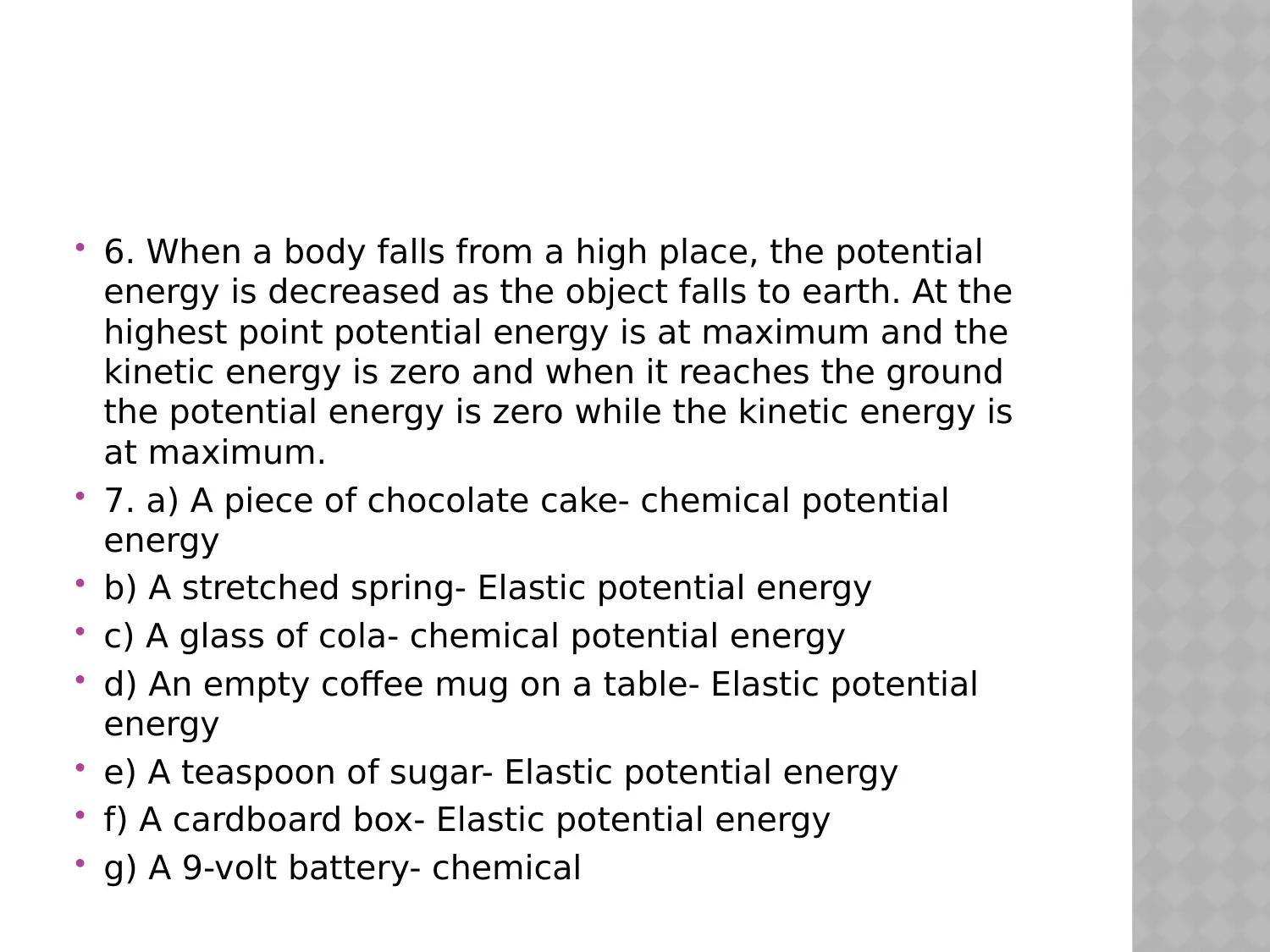
6. When a body falls from a high place, the potential
energy is decreased as the object falls to earth. At the
highest point potential energy is at maximum and the
kinetic energy is zero and when it reaches the ground
the potential energy is zero while the kinetic energy is
at maximum.
7. a) A piece of chocolate cake- chemical potential
energy
b) A stretched spring- Elastic potential energy
c) A glass of cola- chemical potential energy
d) An empty coffee mug on a table- Elastic potential
energy
e) A teaspoon of sugar- Elastic potential energy
f) A cardboard box- Elastic potential energy
g) A 9-volt battery- chemical
energy is decreased as the object falls to earth. At the
highest point potential energy is at maximum and the
kinetic energy is zero and when it reaches the ground
the potential energy is zero while the kinetic energy is
at maximum.
7. a) A piece of chocolate cake- chemical potential
energy
b) A stretched spring- Elastic potential energy
c) A glass of cola- chemical potential energy
d) An empty coffee mug on a table- Elastic potential
energy
e) A teaspoon of sugar- Elastic potential energy
f) A cardboard box- Elastic potential energy
g) A 9-volt battery- chemical
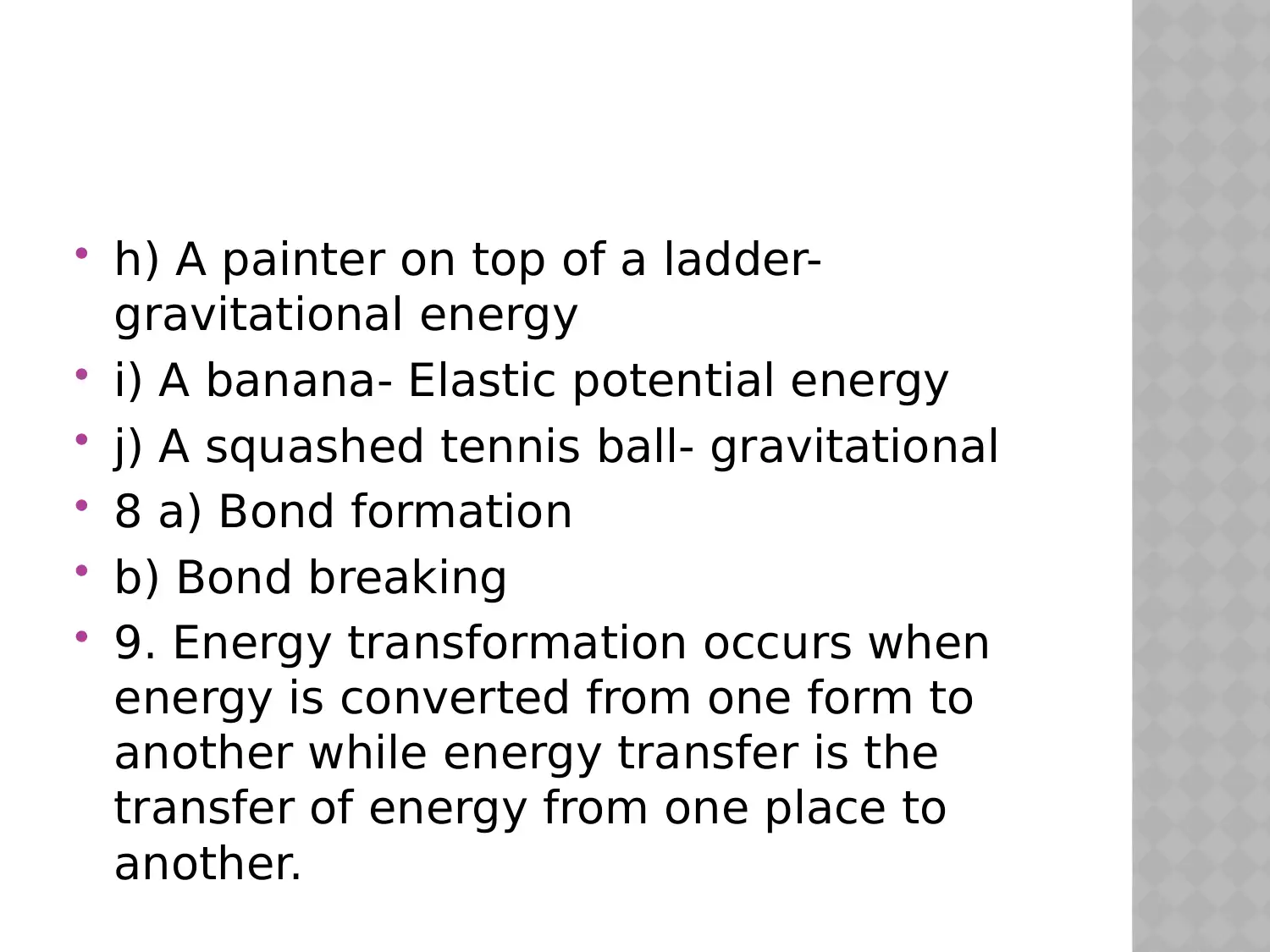
h) A painter on top of a ladder-
gravitational energy
i) A banana- Elastic potential energy
j) A squashed tennis ball- gravitational
8 a) Bond formation
b) Bond breaking
9. Energy transformation occurs when
energy is converted from one form to
another while energy transfer is the
transfer of energy from one place to
another.
gravitational energy
i) A banana- Elastic potential energy
j) A squashed tennis ball- gravitational
8 a) Bond formation
b) Bond breaking
9. Energy transformation occurs when
energy is converted from one form to
another while energy transfer is the
transfer of energy from one place to
another.
⊘ This is a preview!⊘
Do you want full access?
Subscribe today to unlock all pages.

Trusted by 1+ million students worldwide
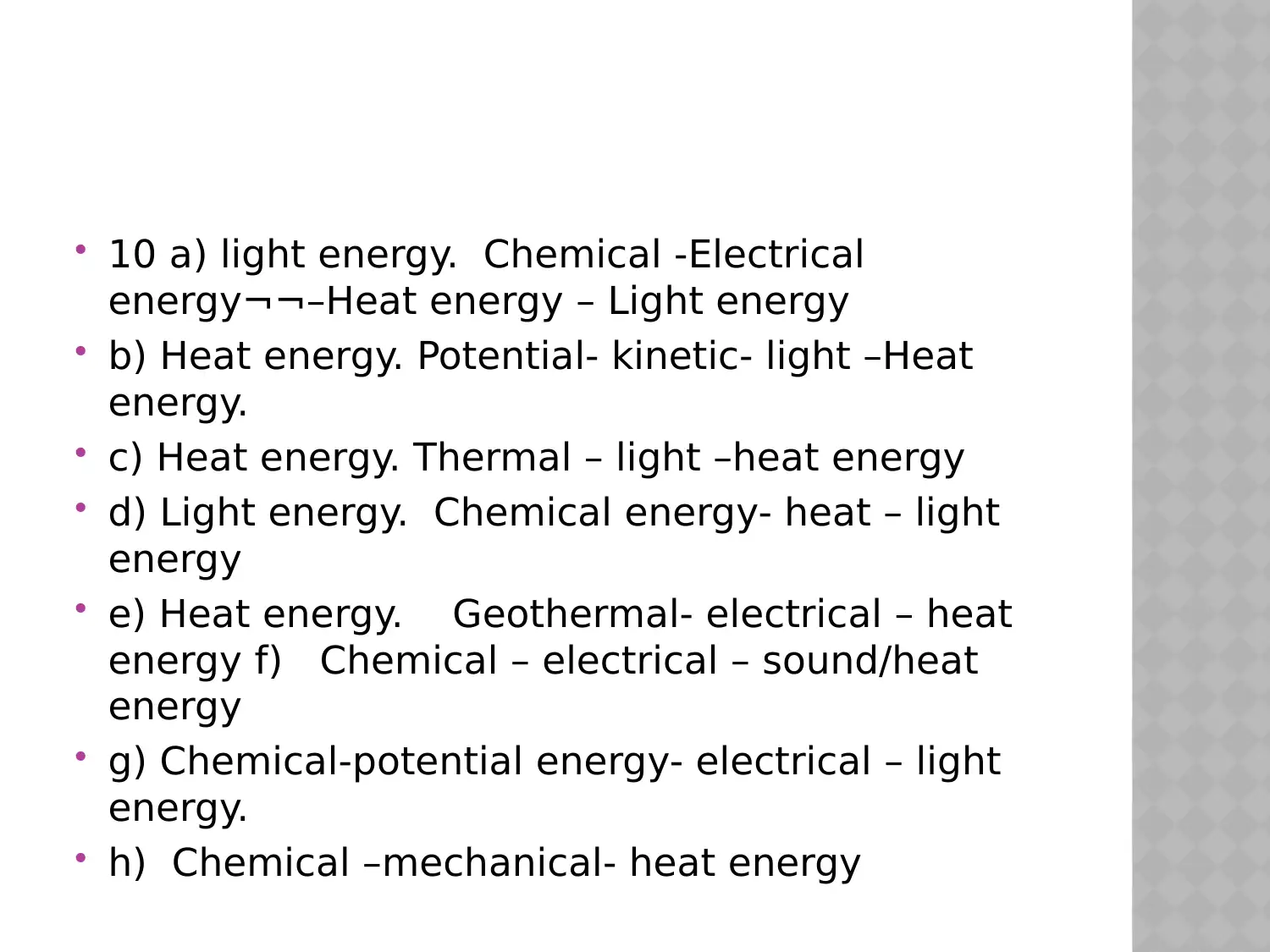
10 a) light energy. Chemical -Electrical
energy¬¬–Heat energy – Light energy
b) Heat energy. Potential- kinetic- light –Heat
energy.
c) Heat energy. Thermal – light –heat energy
d) Light energy. Chemical energy- heat – light
energy
e) Heat energy. Geothermal- electrical – heat
energy f) Chemical – electrical – sound/heat
energy
g) Chemical-potential energy- electrical – light
energy.
h) Chemical –mechanical- heat energy
energy¬¬–Heat energy – Light energy
b) Heat energy. Potential- kinetic- light –Heat
energy.
c) Heat energy. Thermal – light –heat energy
d) Light energy. Chemical energy- heat – light
energy
e) Heat energy. Geothermal- electrical – heat
energy f) Chemical – electrical – sound/heat
energy
g) Chemical-potential energy- electrical – light
energy.
h) Chemical –mechanical- heat energy
Paraphrase This Document
Need a fresh take? Get an instant paraphrase of this document with our AI Paraphraser
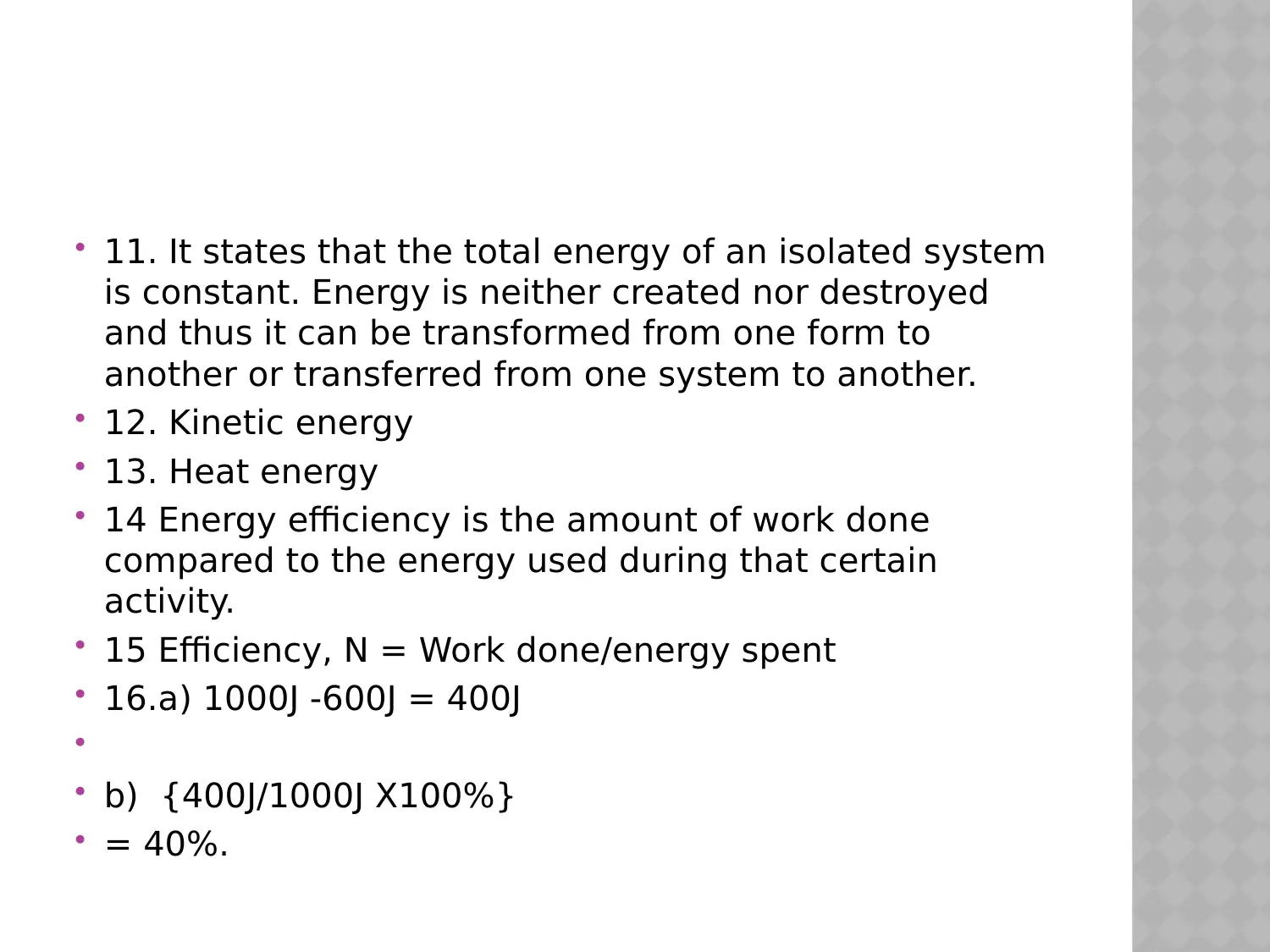
11. It states that the total energy of an isolated system
is constant. Energy is neither created nor destroyed
and thus it can be transformed from one form to
another or transferred from one system to another.
12. Kinetic energy
13. Heat energy
14 Energy efficiency is the amount of work done
compared to the energy used during that certain
activity.
15 Efficiency, N = Work done/energy spent
16.a) 1000J -600J = 400J
b) {400J/1000J X100%}
= 40%.
is constant. Energy is neither created nor destroyed
and thus it can be transformed from one form to
another or transferred from one system to another.
12. Kinetic energy
13. Heat energy
14 Energy efficiency is the amount of work done
compared to the energy used during that certain
activity.
15 Efficiency, N = Work done/energy spent
16.a) 1000J -600J = 400J
b) {400J/1000J X100%}
= 40%.

17. Non-renewable sources of energy do not replenish
in a short period compared to renewable sources.
18. the more the stars the higher the saving cost.
19 i) Ensuring the windows and attics are well
insulated.
ii) Plant shade trees around the home.
iii) Scheduling an energy audit for more expert advice.
iv) Use of compact fluorescent lamps v) Starting a
composite pile
vi) Installing a solar panel
vii) Install a storm door
viii) Buying Energy star products.
20. a) Convection- Heat transfer in liquids.
in a short period compared to renewable sources.
18. the more the stars the higher the saving cost.
19 i) Ensuring the windows and attics are well
insulated.
ii) Plant shade trees around the home.
iii) Scheduling an energy audit for more expert advice.
iv) Use of compact fluorescent lamps v) Starting a
composite pile
vi) Installing a solar panel
vii) Install a storm door
viii) Buying Energy star products.
20. a) Convection- Heat transfer in liquids.
⊘ This is a preview!⊘
Do you want full access?
Subscribe today to unlock all pages.

Trusted by 1+ million students worldwide
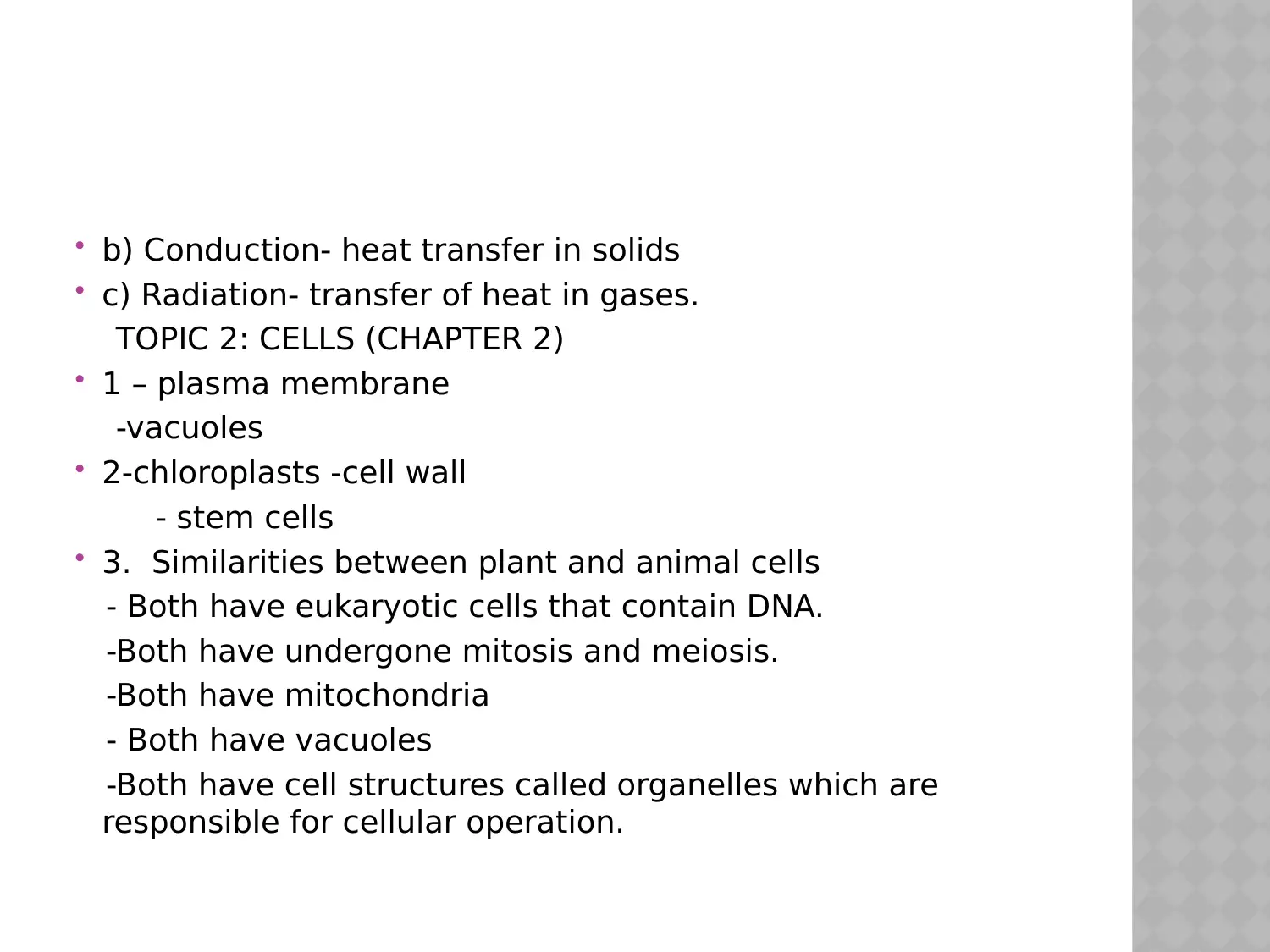
b) Conduction- heat transfer in solids
c) Radiation- transfer of heat in gases.
TOPIC 2: CELLS (CHAPTER 2)
1 – plasma membrane
-vacuoles
2-chloroplasts -cell wall
- stem cells
3. Similarities between plant and animal cells
- Both have eukaryotic cells that contain DNA.
-Both have undergone mitosis and meiosis.
-Both have mitochondria
- Both have vacuoles
-Both have cell structures called organelles which are
responsible for cellular operation.
c) Radiation- transfer of heat in gases.
TOPIC 2: CELLS (CHAPTER 2)
1 – plasma membrane
-vacuoles
2-chloroplasts -cell wall
- stem cells
3. Similarities between plant and animal cells
- Both have eukaryotic cells that contain DNA.
-Both have undergone mitosis and meiosis.
-Both have mitochondria
- Both have vacuoles
-Both have cell structures called organelles which are
responsible for cellular operation.
Paraphrase This Document
Need a fresh take? Get an instant paraphrase of this document with our AI Paraphraser
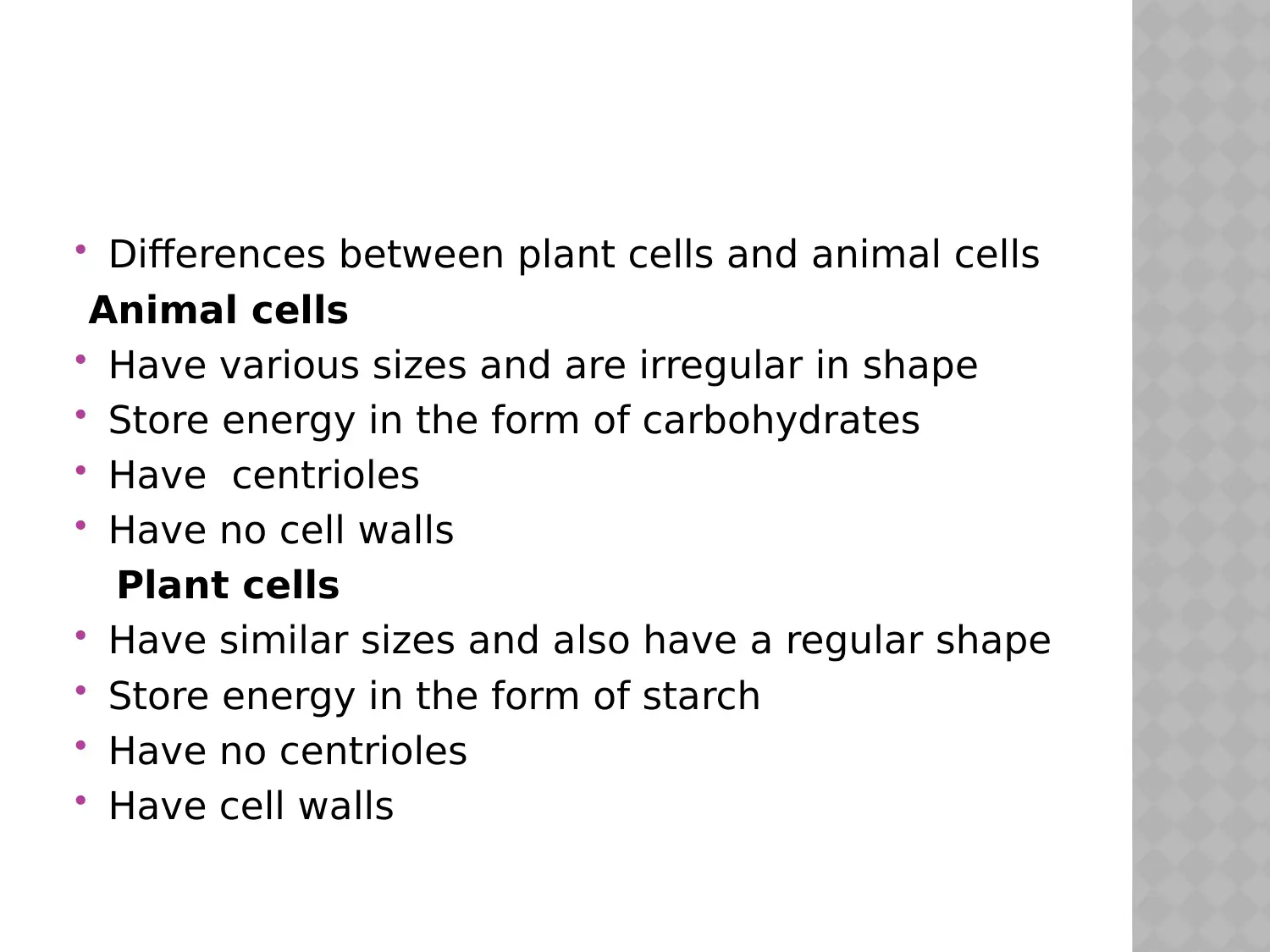
Differences between plant cells and animal cells
Animal cells
Have various sizes and are irregular in shape
Store energy in the form of carbohydrates
Have centrioles
Have no cell walls
Plant cells
Have similar sizes and also have a regular shape
Store energy in the form of starch
Have no centrioles
Have cell walls
Animal cells
Have various sizes and are irregular in shape
Store energy in the form of carbohydrates
Have centrioles
Have no cell walls
Plant cells
Have similar sizes and also have a regular shape
Store energy in the form of starch
Have no centrioles
Have cell walls

Similarities between fungi and bacteria
cells
- Both have cell walls
- Both undergo aerobic respiration
- Both possess cell membranes
composed of phospholipids
Some yeasts and most bacteria
reproduce through binary fission
cells
- Both have cell walls
- Both undergo aerobic respiration
- Both possess cell membranes
composed of phospholipids
Some yeasts and most bacteria
reproduce through binary fission
⊘ This is a preview!⊘
Do you want full access?
Subscribe today to unlock all pages.

Trusted by 1+ million students worldwide
1 out of 32
Your All-in-One AI-Powered Toolkit for Academic Success.
+13062052269
info@desklib.com
Available 24*7 on WhatsApp / Email
![[object Object]](/_next/static/media/star-bottom.7253800d.svg)
Unlock your academic potential
Copyright © 2020–2025 A2Z Services. All Rights Reserved. Developed and managed by ZUCOL.

